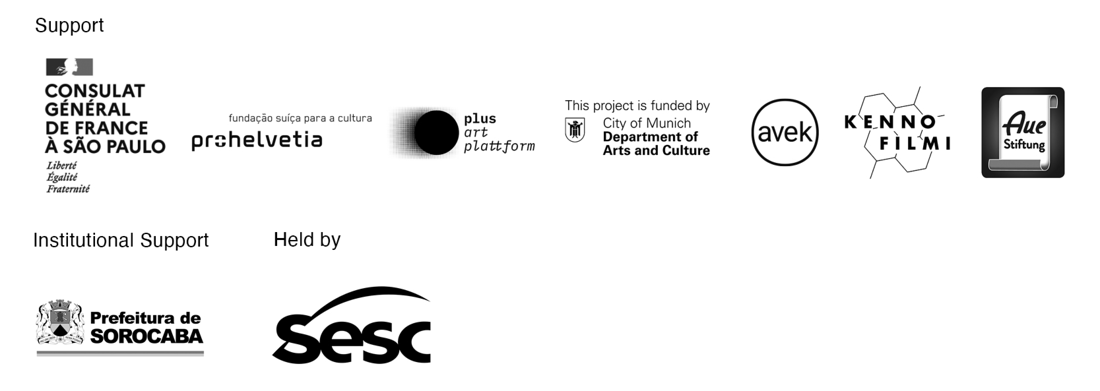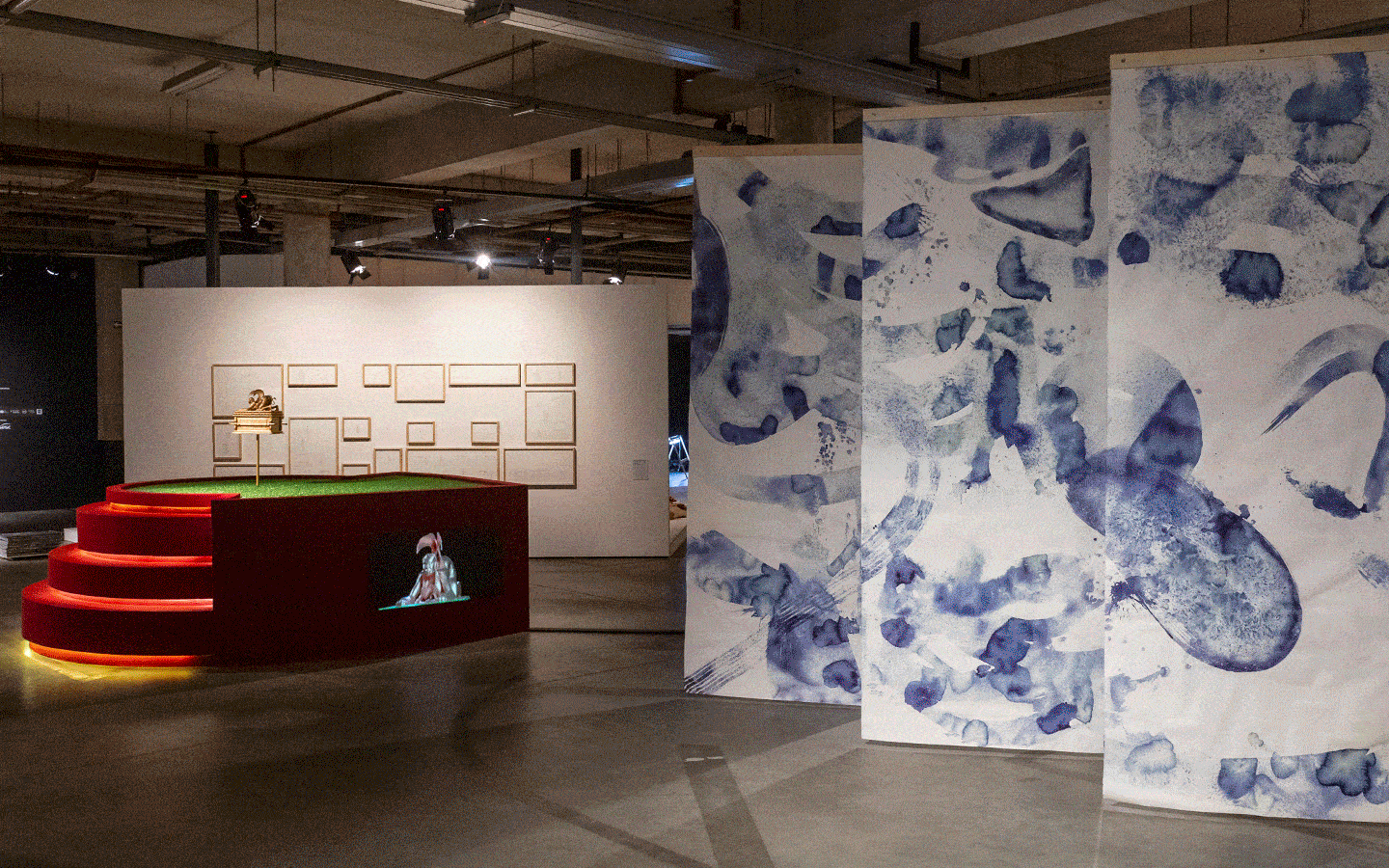The River Is a Serpent
August 21, 2021–January 30, 2022
R. Barão de Piratininga
555 - Jardim Faculdade
Sorocaba-
18030-160
Brazil
In August, the SESC unit in the city of Sorocaba (90 km from São Paulo) opened the exhibition of the third edition of Frestas – Triennial of Arts, curated by Beatriz Lemos, Diane Lima and Thiago de Paula Souza, with curating assistance by Camila Fontenele and educational coordination by Renata Sampaio. Originally planned to have taken place in the second semester of 2020, instead Frestas began, at that moment, to carry out a series of formative practices along with a study group dedicated to thinking about what it is to make an art exhibition in times of pandemic. Now, with the show open to the public, the platform is also advancing with its public program and, soon, the release of publications.
The River Is a Serpent – 3rd Frestas – Triennial of Arts takes as its starting point the interest in the negotiations and strategies found by artists to escape from socially imposed limits and to fabulate, even if temporarily, ways of life that can contribute toward putting an end to a world in which differences spell inequalities. This edition of Frestas raises discussions about the redistribution of accesses and investigates how artistic practices can contribute toward ending the perverse logics that transform lives into merchandise, silence dissidences, and impose consensuses.
Works by 53 artists and artist collectives from different parts of the world (complete list below) compose the show. Although most of the artworks are being shown in a large space at SESC Sorocaba dedicated entirely to the exhibition, others are located in other areas within the unit—such as its cable-stayed pedestrian walkway which is receiving the enormous serpents of Jaider Esbell’s intervention; the amphitheater, with works by Haseeb Ahmed, Paulo Nazareth, Rommulo Vieira Conceição and Pedro Victor Brandão; and the ground floor, with an installation by Musa Michelle Mattiuzzi.
Other works are found outside the unit, in public spaces scattered around the city of Sorocaba, such as the intervention by Jota Mombaça on the asphalt, with the words “A fuga só acontece porque é impossível” [Escape only takes place because it’s impossible] taking up a long stretch of an avenue near SESC; a billboard with an intervention by Zumvi Arquivo Fotográfico; and, at Biquinha National Park, the installation Labirinto, by Sallisa Rosa and Sucata Quântica, and Esculturas para bailar merengue, by Engel Leonardo.
“When we think about how the cultural institutions, like the museums or even the art galleries, have been working within a system of erasure, of excluding most of the racialized, dissident, black and indigenous artists, we will understand that here there is a massive presence of these artists, and that together they form this set of works which, often, we could not see in other places,” stated Diane Lima in the exhibition’s opening program livestreamed on August 21.
“What we are doing here is not exactly ‘for the first time,’ adds Thiago de Paula Souza. “It’s possible to do it now and perhaps it was not possible to do it 30 years ago, at least not in this way. But we are informed by the discussions that took place 30 years ago, which took place 60 years ago.”
“Bodies and subjectivities that historically underwent processes of oppression have the wisdom of this technology in their body, and spiritually as well: the technology of escape. But this learning never comes by itself. It always comes with the possibility of a shortcut as well. And here we talk a lot about those shortcuts,” explains Beatriz Lemos. “Many of these shortcuts that we can see here at the exhibition talk about community, they talk about the exercise of self-care, of access and of listening to plants, of a non-Occidental idea of nature, of self-love […] and, mainly, of narratives. Narratives of life, of happiness, of joy, of leisure and of pleasure.”
“Frestas is a path, it is a rupture, it is something that you open there in the middle of any reality at all, penetrating it with concepts, ideas and proposals, which are indispensable for the moment—at a moment in which we have to discuss very serious questions of the human being related to our life in society, to our understanding of our reality, to the overcoming therefore, of prejudices, to the question of diversity pushed to the utmost, very radically,” states the director of SESC São Paulo, Danilo Santos de Miranda. “All this is very present in our proposal—of contemporary art generally, and in the contemporary art proposed there in the city of Sorocaba, in this triennial called Frestas.”
List of artists
Aimée Zito Lema, Ana Pi and Maria Fernanda Novo, Antonio Társis, Bronwyn Katz, Carmézia, Castiel Vitorino Brasileiro, coletivA ocupação, Colectivo Ayllu, Dalton Paula, Davi de Jesus do Nascimento, Davi Pontes and Wallace Ferreira, Denilson Baniwa, Denise Alves-Rodrigues, Diego Araúja, Ella Vieira, Elvira Espejo, Engel Leonardo, Fernando Palma Rodríguez, Gê Viana, Guerreiro do Divino Amor, Haseeb Ahmed, Iagor Peres, Ivan Henriques, Jaider Esbell, Johanna Unzueta, Jonas van Holanda, Jota Mombaça, Juliana dos Santos, Julien Creuzet, Lais Machado, Laura Lima, Lia García (La Novia Sirena), Luana Vitra, Madalena Santos Reinbolt, Marepe, Mário Lopes, Musa Michelle Mattiuzzi, Negalê Jones, Noara Quintana, Nohemí Pérez, Paulo Nazareth, Pêdra Costa, Pedro Victor Brandão, Rebeca Carapiá, Rommulo Conceição, Sabelo Mlangeni, Sallisa Rosa and Sucata Quântica, Shirley Villavicencio Pizango, Tabita Rezaire, Thiago Martins de Melo, Ventura Profana, Vijai Patchineelam and Zumvi Arquivo Fotográfico
About SESC São Paulo
SESC – Social Service of Commerce is a private, nonprofit institution created in 1946 by businesspeople in the commerce and services sector from all over Brazil. In the State of São Paulo, SESC has 42 centers providing public access to culture, education, sports, leisure, and health. SESC São Paulo’s actions are oriented by its educational aim and its striving for social welfare based on a broader understanding of the term culture.
At this moment, in-person visits to exhibitions at units of SESC São Paulo are only possible through prior scheduling online and in accordance with the protocols established by the local authorities for the combat of COVID-19.



